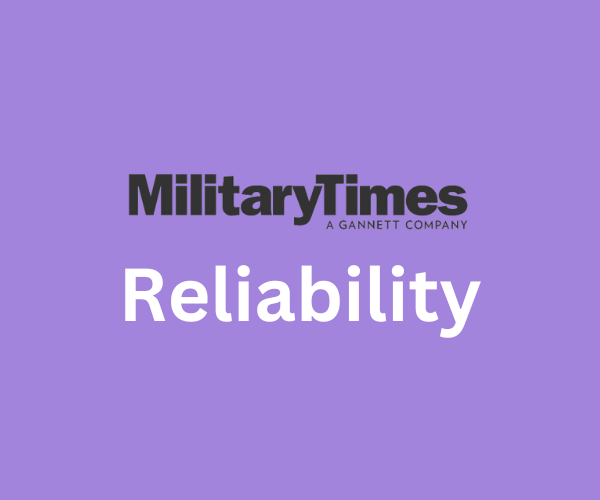
According to Sightline, the Military Times is a combination of Army Times, Marine Corps Times, Navy Times, and Air Force Times. The Military Times claims to provide veterans, active military members, and their families with a reliable, independent news source. The news reported in the Military Times is typically relating to the military and its members.
Because of its targeted audience, is the Military Times reliable and credible? At Biasly, we endeavor to evaluate the accuracy and dependability of all media outlets. Let us investigate the reliability and accuracy of the Military Times.
Does Reliability Matter?
Reliability, in general, refers to how trustworthy or accurate information, or in this case, a news source is. If we consider this definition, it quickly becomes clear why reliability is important in media sources. If we can’t trust the things we read then there isn’t much of a point in continuing to consume content from that source, after all. So how exactly can we gauge the reliability of a news source anyways?
There are several potential measures of reliability to look out for when trying to determine whether a media source is reliable or not. Red flags for an unreliable article can include the presence of wild unsubstantiated claims, facts dependent on other unreliable sources, heavy use of opinionated language, and more. Some indicators of a reliable news source, on the other hand, include things like:
- Absence of subjective/opinionated language in articles
- Credible sources cited (e.g., neutral sources, .gov, .edu websites)
- Facts and statistics backed by multiple relevant outside sources
- Use of primary sources when possible (e.g., interviews, quotes)
- Information that remains consistent across news sources
How Does the Military Times Fare in its Reliability?
The political reliability index developed by Biasly objectively assesses news organizations’ accuracy and trustworthiness. The Military Times overall Source Reliability Score has been rated as ‘Fair’ by Biasly.
The Source Reliability Score suggests readers can somewhat trust the quality and completeness of sources, links, and quotes provided by the news source. This score, which is based on AI, focuses on assessing the quality of sources and quotes used including their number, lengths, uniqueness, and diversity.
However, since these scores are based on percentages and averages, individual articles could be more or less trustworthy depending on the context, author, and other factors. Our findings show that the Military Times’ reliability is mostly but not all factual because they have retracted several stories in the past or had pieces that were not factual.
Let us analyze the supporting data for the Military Times’ rankings and discuss what to watch out for while searching for trustworthy news sources.
The Military Times Accuracy and Reliability
The credibility of news organizations is significantly impacted by bias and political orientation. Like numerous other media organizations, the Military Times has occasionally been accused of prioritizing the Republican agenda above facts. Although it is deemed an “independent news source”, some of its articles tend to show a bias towards the Republican party.
We can evaluate the integrity of the Military Times’ news stories and deduce how well the publication supports assertions with evidence, and see whether this is indeed the case. We will check for selection and omission bias as we assess the articles’ correctness and factuality.
Selection bias is when stories and facts are selected or deselected, often on ideological grounds, to create a narrative in support of the new sources’ ideology. Omission bias, on the other hand, is when different opinions and political views regarding a situation are left out so that the reader is only exposed to the ideological perspective supported by the author. It’s important to keep in mind these two types of biases when trying to assess an article’s level of accuracy.
Biasly assigns a percentage score to accuracy, with one being the least accurate and 100 being the most. Ratings are calculated by weighing assertions with supporting evidence, the number of reliable internal sources, and the number of reliable external sources employed. A full page at Biasly’s website includes dependability and accuracy ratings for newly released Military Times news stories. As we previously stated, according to the reports analytics have assessed, the Military Times has a ‘Fair’ reliability score. This score can vary from article to article, though, and the most extreme variations in dependability are caused by bias, notably omission, and selection bias. Consider also, AP News, which has a “Center” Bias and a “Good” analyst reliability score according to Biasly. For example, they had one article that had a “Fair” reliability score titled, “Trump Calls for GOP Unity, Repeats Lies about Election Loss,” and another article called, “Pelosi Taps DC National Guard Head to Lead House Security,” that had an “Excellent” reliability score. As a result, stories displaying political leaning are less reliable than neutral ones.
For instance, this Military Times article titled, “Ukraine Uses US Weapons to Strike Inside Russia” is rated as Medium Conservative. Concerning the selection and omission bias, the author, Aamer Madhani, does a good job of getting multiple quotes from people who work with the weapons used. However, some of his sources are anonymous which makes it hard to identify if they are reliable. Madhani’s source, John Kirby, the White House National Security Spokesman, says in his statement:
“‘We’re just not in a position on a day-to-day basis of knowing exactly what the Ukrainians are firing at what,’ Kirby said. ‘It’s certainly at a tactical level.’”
This article portrays a conservative stance, mostly due to its indication that the U.S. does not care what Ukraine is using the weapons for. This is shown through its inclusion of direct quotes and facts. It does not factor opinions into the article. However, Madhani fails to balance his sources while reporting on this subject matter. If he had included more from Ukraine, they could provide a more central view of the issue, rather than a conservative view. Therefore this article can be considered somewhat reliable.
We will take a closer look at more examples like this below, providing a further investigation into the reliability of the Military Time’s articles. This will include its use of selection bias, omission bias, and the quality of its sources and facts used.
Analysis of Reliability in the Military Times Opinion Pieces
Opinion-style journalism is a suitable venue for reporters to express their opinions and beliefs, even if excessive opinion might be something to avoid while producing a general news article. Although opinion pieces are less trustworthy because they are subjective, they can still be worthwhile to read to increase one’s understanding of various political viewpoints.
The Military Times’ opinions have caused some issues in the past with their reliability in their tendency to promote conservative ideologies and individuals; the group has been involved in some controversies where they have been charged with having a deep bias against other countries. The article, “Unleash the Space Force,” was written as an opinion piece for Military Times, and it is definitely an opinion piece as noted with its exclusion and abundance of one-sided data. These pieces led to readers feeling scared with the message. Their dislike for China’s progress is very abundant throughout the piece. The data used makes the piece read as a call-to-action.
Quality of Sources and Facts Used
The Military Times can be good at using reliable sources from both sides of the ideological divide and citing facts as evidence, however, this is not the case for every article. For instance, think about, “Fertility Clinics are in Need of Provincial Oversight.” In this article from Joyce Ghaly, she didn’t use any quotes, but she did provide four examples of their claims. Of those four examples, all four supported her claim, allowing no support for the other side.
In addition to that, the author’s three sources for the article were as follows:
- The Norman Barwin case
- Author’s Unknown Client
- Qi Zhang, lost 65 egg’s in a freezer malfunction
The number of sources used is a little lacking, but the diversity and credibility appear to be the biggest problem, as two of them are drastic incidents, one is the author’s client, and none are in support of the other side. The lack of sources supporting her claims against these private fertility centers is also concerning. The article is accurate in its statement of facts but provides no evidence to support its negative claims about these fertility clinics. They consistently lean towards the disapproval of the fertility clinic’s regulations when writing it, giving an average quality source and a lack of holistic facts to the article.
The author, Joyce Ghaly, only uses sources supporting her take on the problem, like the Norman Barwin case, the unknown client, and Qi Zhang. The author also paraphrases a lot and leaves out key pieces of information to direct the thoughts of the readers. This is shown when she says:
“ICSI’s efficacy and necessity are not nearly as well studied as they should be.”
Here she makes a generalizing statement without actually including any of the studies that have been conducted on ICSI’s efficacy and necessity. Although there may not be tons of studies done on ICSI, if all of the studies that have been done come to the same conclusion, this consistency could be the reason why there haven’t been more studies done on it. This left-out information can lead the reader to believe that ICSI has barely been tested. The evidence, then, points to this article as not being as trustworthy as it could be for information on infertility clinics.
In the article, Ghaly makes many claims and presents them as facts, but doesn’t have evidence to support them. One is:
“A stark example came about in 2018 where a woman in Toronto lost 65 frozen eggs due to the malfunction of a cryogenic storage tank. Such incidents would be significantly less common if the industry was stringently regulated.”
She doesn’t provide any research or evidence supporting the claim that cryogenic storage tank malfunctions would be less common with more government regulations. She does this again when she says:
“But how can fertility doctors obtain true informed consent for procedures like ICSI when doctors themselves lack comprehensive knowledge of the risks and benefits, given the procedure is not well studied?”
Here she states that the procedure is not well studied, but has no evidence in support of that claim. She uses unsubstantiated claims to further her overall claim of needing more regulation, which is a left-leaning ideal. To strengthen her position, she could use more facts and sources from experts or provide more evidence for her claims.
So Is the Military Times Reliable?
Finally, it can be argued that the Military Times is a fairly reliable news source with an adequate reputation for journalistic integrity, and some lone exceptions, therefore the degree of truth in its publications fluctuates. The more you research media reliability and accuracy, the simpler it will be for you to spot problems with sources, selection, omission, and factuality. To help with this, you can use Biasly’s News Bias Checker to uncover reliability problems and assist you in finding the most accurate and dependable news.






















